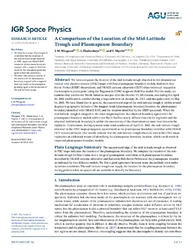A Comparison of the Location of the Mid‐Latitude Trough and Plasmapause Boundary
DOI: https://doi.org/10.1029/2020JA028213
Persistent URL: http://resolver.sub.uni-goettingen.de/purl?gldocs-11858/9551
Persistent URL: http://resolver.sub.uni-goettingen.de/purl?gldocs-11858/9551
Weygand, J. M.; Zhelavskaya, I.; Shprits, Y., 2021: A Comparison of the Location of the Mid‐Latitude Trough and Plasmapause Boundary. In: Journal of Geophysical Research: Space Physics, Band 126, 4, DOI: 10.1029/2020JA028213.
 |
Dokument öffnen: |
Abstract:
We have compared the location of the mid‐latitude trough observed in two dimensional vertical total electron content (vTEC) maps with four plasmapause boundary models, Radiation Belt Storm Probes (RBSP) observations, and IMAGE extreme ultraviolet (EUV) observations all mapped to the ionosphere pierce point using the Tsyganenko (1996) magnetic field line model. For this study, we examine four events over North America: one just after the October 13, 2012 storm, one during the April 20, 2002 double storm, another during a large substorm on January 26, 2013, and one quiet event on May 19, 2001. We have found that in general, the equatorward edge of the mid‐latitude trough is within several degrees in geographic latitude of the mapped model plasmapause boundary location, the plasmapause boundary identified with IMAGE EUV, and the location identified by the RBSP spacecraft. When the mid‐latitude trough is mapped to the inner magnetosphere, the observed boundary agrees with the plasmapause boundary models within two Earth Radii at nearly all local times in the nightside and the observed mid‐latitude boundary is within the uncertainty of the observations at most local times in the nightside. Furthermore, during dynamic solar wind conditions of April 20, 2002, the mid‐latitude trough observed in the vTEC maps propagates equatorward as the plasmapause boundary identified with IMAGE EUV moves earthward. Our results indicate that the mid‐latitude trough observed within the vTEC maps represents an additional means of identifying the plasmapause boundary location, which could result in improved plasmapause boundary models. Plain Language Summary:
The equatorward edge of the mid‐latitude trough as observed in TEC maps indicates the location of the plasmapause boundary. We compare the location of the mid‐latitude trough for four events over a range of geomagnetic conditions with plasmapause boundary identified by IMAGE extreme ultraviolet and Radiation Belt Storm Probes and the plasmapause location as indicated by four different models. We find a good agreement between some the methods even under dynamics conditions. The mid‐latitude trough can supply the location for the plasmapause boundary during periods when no spacecraft are available to identify the boundary. Key Points:
We show for a range of geomagnetic conditions that the locations of the mid‐latitude trough observed in vTEC maps and IMAGE EUV measured plasmapause boundary mapped with a magnetic field line model to the ionosphere generally agree within the uncertainty.
We show that common models of the position of the plasmapause boundary mapped with a magnetic field line model to the ionosphere generally agree with the location of the mid‐latitude trough.
Statistik:
ZugriffsstatistikSammlung:
This is an open access article under the terms of the Creative Commons Attribution License, which permits use, distribution and reproduction in any medium, provided the original work is properly cited.

